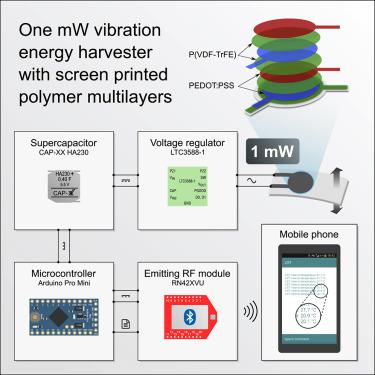Cell Reports Physical Science ( IF 7.9 ) Pub Date : 2020-05-27 , DOI: 10.1016/j.xcrp.2020.100068 Nicolas Godard , Lucas Allirol , Antoine Latour , Sebastjan Glinsek , Mathieu Gérard , Jérôme Polesel , Fabrice Domingues Dos Santos , Emmanuel Defay

|
Energy harvesters are required for autonomous sensors. The field is still missing a low-cost technology that would provide enough power for tangible low-frequency use cases, although triboelectric nanogenerators (TENG) have emerged as a new energy technology. Standard vibration energy harvesters (VEHs) are based either on bulky electromagnetic systems or stiff lead-based piezo-ceramics. Those systems are rarely compatible with large deformations that occur at low frequency such as body movements. Here, we show that a stack of 10 thin layers of poly(vinylidene fluoride trifluoroethylene) screen printed on a polymer substrate can harvest up to 0.97 mW at 33 Hz with an area of only 2.4 cm2. These results are obtained with a lead-free, cost-effective, and scalable technique at 150°C, competing with TENG solutions. This VEH can work for at least 107 cycles while harvesting sufficient energy to feed a microcontroller that communicate wirelessly with a mobile phone.
中文翻译:

基于带有打印聚合物多层悬臂的1mW振动能量采集器
自主传感器需要能量收集器。尽管摩擦电动纳米发电机(TENG)已经作为一种新的能源技术出现,但该领域仍缺少一种能够为有形低频用例提供足够功率的低成本技术。标准的振动能量收集器(VEH)基于庞大的电磁系统或基于硬铅的压电陶瓷。这些系统很少与低频发生的大变形(例如人体运动)兼容。在这里,我们显示了在聚合物基材上丝网印刷的10层薄薄的聚偏二氟乙烯三氟乙烯筛网的叠层可以在33 Hz的频率下仅面积2.4 cm 2收获高达0.97 mW。这些结果是通过在150°C下与TENG解决方案竞争的无铅,经济高效且可扩展的技术获得的。该VEH可以工作至少10 7个周期,同时收集足够的能量,以为与手机进行无线通信的微控制器供电。











































 京公网安备 11010802027423号
京公网安备 11010802027423号